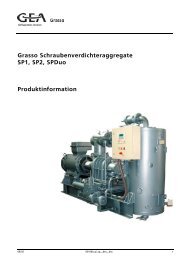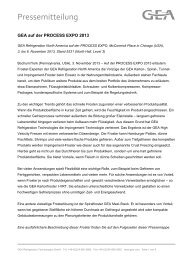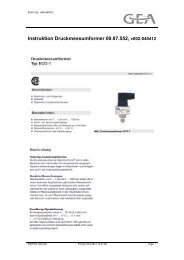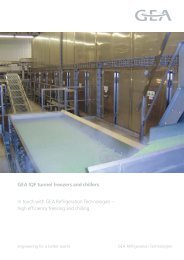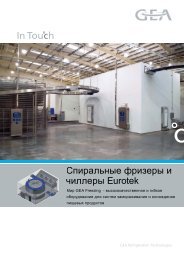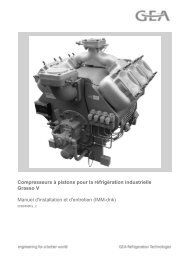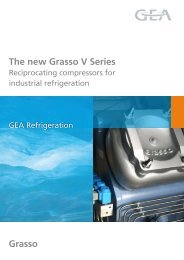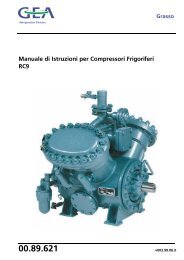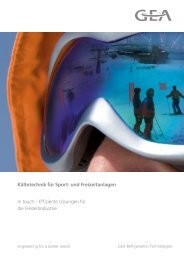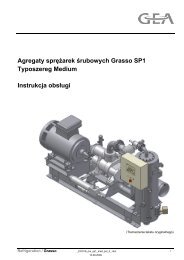TECHNICAL INFORMATION GRASSO SCREW COMPRESSORS ...
TECHNICAL INFORMATION GRASSO SCREW COMPRESSORS ...
TECHNICAL INFORMATION GRASSO SCREW COMPRESSORS ...
Create successful ePaper yourself
Turn your PDF publications into a flip-book with our unique Google optimized e-Paper software.
<strong>TECHNICAL</strong> <strong>INFORMATION</strong><br />
<strong>GRASSO</strong> <strong>SCREW</strong> <strong>COMPRESSORS</strong><br />
Types C ... XF<br />
LUBRICATING OILS FOR <strong>SCREW</strong> <strong>COMPRESSORS</strong><br />
1 LUBRICATING OILS FOR <strong>SCREW</strong> <strong>COMPRESSORS</strong><br />
1.1 Lubricating oil selection list<br />
Special refrigeration oils must be used for Grasso screw compressors. The selection of the oils depends on the<br />
chemical properties of the oil, the refrigerants, the operating conditions of the plant and the required oil viscosity<br />
during startup and run. After inquiring with the compressor manufacturer, oils other than those listed in the table<br />
may also be used. For further information on the listed oils please refer to the data sheets and diagrams of the oil<br />
manufacturers. For refrigeration compressors special refrigeration oils have to be used. The selection depends on<br />
the refrigerant, viscosity (at least 7 cSt for oil temperature before entering the compressor), evaporating<br />
temperature (pour point) and requirement made of the oil separation behaviour (flash point, viscosity).<br />
Basis of the lubricating oils and used abbreviations<br />
M<br />
M *<br />
AB<br />
PAO<br />
E<br />
PAG<br />
Mineral oil<br />
Mineral oil with special treatment (hydrocracked oil)<br />
Alcylbenzene<br />
Polyalphaolefin<br />
Polyolester<br />
Polyalcyl glycol<br />
Table 1: Lubricating oils for R717 (Ammonia)<br />
(recommended especially if minimum oil carry over is important)<br />
Manufacturer Type of oil<br />
Basis<br />
Viscosity<br />
at<br />
40°C in cSt<br />
Flash point<br />
in °C<br />
Pour point<br />
in °C<br />
Remark NSF Grade 2)<br />
CPI<br />
Klüber<br />
Lubrication<br />
Shell<br />
CP 1009-68 M * 68 226 -40 H2<br />
CP 1008-68 M * 64.9 240 -39 H2<br />
Klüber<br />
Summit<br />
RHT 68<br />
M * 68 240 -39 H2<br />
Shell<br />
Clavus S M * 68 232 -39<br />
68 1)<br />
Petro Canada Reflo 68A M * 58 236 -42 H2<br />
TEXACO<br />
Hydrotreated<br />
Capella<br />
M * /PAO 67 262 -42 for R717<br />
Premium<br />
only<br />
Paramo<br />
Mogul<br />
Komprimo<br />
ONC 68<br />
M * 68 230 -33<br />
TOTAL<br />
Fuchs<br />
NXT<br />
Next<br />
Lubricants<br />
Lunaria NH<br />
68<br />
Reniso<br />
Ultracool 68<br />
M * 68 230 -36<br />
M * /PAO 62 250 -48<br />
NXT-717 M * 60.6 249 -56<br />
GEA Refrigeration Germany GmbH _165520_ti_sc_gbr_4_.doc 1<br />
11.01.2013
<strong>TECHNICAL</strong> <strong>INFORMATION</strong><br />
<strong>GRASSO</strong> <strong>SCREW</strong> <strong>COMPRESSORS</strong><br />
Types C ... XF<br />
LUBRICATING OILS FOR <strong>SCREW</strong> <strong>COMPRESSORS</strong><br />
1) Product not longer available.<br />
2) Application area in food-processing industrie according to NSF (National Sanitation Foundation, www.nsf.org)<br />
– H1: Applicable in all food-processing environments where there is the possibility of incidental food contact.<br />
– H2: Applicable in all food-processing environments where there is no possibility of incidental food contact.<br />
2 _165520_ti_sc_gbr_4_.doc GEA Refrigeration Germany GmbH<br />
11.01.2013
<strong>TECHNICAL</strong> <strong>INFORMATION</strong><br />
<strong>GRASSO</strong> <strong>SCREW</strong> <strong>COMPRESSORS</strong><br />
Types C ... XF<br />
LUBRICATING OILS FOR <strong>SCREW</strong> <strong>COMPRESSORS</strong><br />
Lubricating oils for DX Chiller with R717 (Ammonia)<br />
Manufacturer Type of oil<br />
Basis<br />
Viscosity<br />
at<br />
40°C in cSt<br />
Flash point<br />
in °C<br />
Pour point<br />
in °C<br />
Remark NSF Grade 2)<br />
CPI CP 412-100 PAG 98 226 -40<br />
Fuchs<br />
Fuchs<br />
Reniso PG<br />
68<br />
PAG 62 230 -35<br />
Shell<br />
Shell<br />
Clavus SG<br />
68<br />
PAG 73.5 >250 -48<br />
Mobil<br />
Mobil<br />
Zerice S32<br />
AB 32 154 -33<br />
Please<br />
contact<br />
manufacturer<br />
2) Application area in food-processing industrie according to NSF (National Sanitation Foundation, www.nsf.org)<br />
– H1: Applicable in all food-processing environments where there is the possibility of incidental food contact.<br />
– H2: Applicable in all food-processing environments where there is no possibility of incidental food contact.<br />
GEA Refrigeration Germany GmbH _165520_ti_sc_gbr_4_.doc 3<br />
11.01.2013
<strong>TECHNICAL</strong> <strong>INFORMATION</strong><br />
<strong>GRASSO</strong> <strong>SCREW</strong> <strong>COMPRESSORS</strong><br />
Types C ... XF<br />
LUBRICATING OILS FOR <strong>SCREW</strong> <strong>COMPRESSORS</strong><br />
Lubricating oils for R717 (Ammonia) and R22<br />
Manufacturer Type of oil Basis<br />
Viscosity<br />
at<br />
40°C in cSt<br />
Flash point<br />
in °C<br />
Pour point<br />
in °C<br />
Remark NSF Grade 2)<br />
Castrol<br />
Icematic 299 M 56 180 -34<br />
Icematic<br />
2294<br />
PAO 69 233 -60<br />
for R717<br />
only<br />
CPI<br />
CP-4600-<br />
46F<br />
PAO 46 268 -51<br />
for R717<br />
only<br />
H1<br />
Zerice S32 AB 32 154 -33<br />
Zerice S68 AB 68 174 -27<br />
Gargoyle<br />
Arctic SHC<br />
226E<br />
PAO 68 266 -45<br />
for R717<br />
only<br />
H1<br />
MOBIL<br />
Gargoyle<br />
Arctic SHC<br />
NH 68<br />
Gargoyle<br />
Arctic 300<br />
Gargoyle<br />
Arctic C<br />
Heavy<br />
AB/PAO 64 211 -54<br />
M 68 200 -42<br />
M 46 195 -42<br />
Fuchs<br />
Shell<br />
Reniso S68 AB 68 190 -33<br />
Reniso<br />
Synth 68<br />
Reniso KS<br />
46<br />
Reniso KC<br />
68<br />
PAO 68 260 -57<br />
M 46 195 -42<br />
M 68 200 -39<br />
Shell Clavus<br />
1) M 44 195 -39<br />
46<br />
Shell Clavus<br />
1) M 65 205 -36<br />
68<br />
for R717<br />
only<br />
Shell Clavus<br />
1) M 44 195 -39<br />
G46<br />
for R22 only<br />
Shell Clavus<br />
G68 1) M 65 205 -36<br />
Shell<br />
Refrigeration<br />
Oil S4 FR-V<br />
46<br />
AB 46 180 -42<br />
for R717<br />
only<br />
H1<br />
4 _165520_ti_sc_gbr_4_.doc GEA Refrigeration Germany GmbH<br />
11.01.2013
<strong>TECHNICAL</strong> <strong>INFORMATION</strong><br />
<strong>GRASSO</strong> <strong>SCREW</strong> <strong>COMPRESSORS</strong><br />
Types C ... XF<br />
LUBRICATING OILS FOR <strong>SCREW</strong> <strong>COMPRESSORS</strong><br />
Manufacturer Type of oil Basis<br />
Viscosity<br />
at<br />
40°C in cSt<br />
Flash point<br />
in °C<br />
Pour point<br />
in °C<br />
Remark NSF Grade 2)<br />
Shell<br />
Refrigeration<br />
Oil S4 FR-V<br />
68<br />
AB 68 190 -39<br />
Lunaria NH<br />
46<br />
M 46 226 -36<br />
for R717<br />
only<br />
TOTAL<br />
Lunaria SH<br />
46<br />
PAO 44 252 -51<br />
for R717<br />
only<br />
H1<br />
Lunaria FR<br />
68<br />
M 68 175 -34 for R22 only<br />
Petro Canada<br />
Reflo<br />
Synthetic<br />
68A<br />
AB/PAO 62 245 -54<br />
for R717<br />
only<br />
1) Product not longer available.<br />
2) Application area in food-processing industrie according to NSF (National Sanitation Foundation, www.nsf.org)<br />
– H1: Applicable in all food-processing environments where there is the possibility of incidental food contact.<br />
– H2: Applicable in all food-processing environments where there is no possibility of incidental food contact.<br />
GEA Refrigeration Germany GmbH _165520_ti_sc_gbr_4_.doc 5<br />
11.01.2013
<strong>TECHNICAL</strong> <strong>INFORMATION</strong><br />
<strong>GRASSO</strong> <strong>SCREW</strong> <strong>COMPRESSORS</strong><br />
Types C ... XF<br />
LUBRICATING OILS FOR <strong>SCREW</strong> <strong>COMPRESSORS</strong><br />
Lubricating oils for R134a; R404A; R407C; R410A; R507<br />
Manufacturer Type of oil Basis<br />
Viscosity<br />
at<br />
40°C in cSt<br />
Flash point<br />
in °C<br />
Pour point<br />
in °C<br />
Remark NSF Grade 2)<br />
Castrol<br />
Icematic SW<br />
68<br />
Icematic SW<br />
220<br />
E<br />
68 250 -39<br />
220 290 -26<br />
Solest 68 64 266 -43<br />
CPI<br />
Solest 120 E 125 262 -27<br />
Solest 220<br />
216 271 -27<br />
Reniso<br />
Triton SE 55<br />
53 270 -51<br />
Reniso<br />
Triton SEZ<br />
80<br />
80 275 -39<br />
Fuchs<br />
Reniso<br />
Triton SEZ<br />
100<br />
E<br />
91 288 -39<br />
Reniso<br />
Triton SE<br />
170<br />
170 260 -24<br />
Reniso PAG<br />
220<br />
PAG 220 240 -38<br />
for R134a<br />
only<br />
Shell<br />
1) 64 250 -54<br />
ClavusR68<br />
Shell Clavus<br />
1) 93 280 -45<br />
R 100<br />
Shell<br />
Shell<br />
Refrigeration<br />
Oil S4 FR-F<br />
68<br />
E<br />
66 230 -42<br />
Shell<br />
Refrigeration<br />
Oil S4 FR-F<br />
100<br />
94 230 -42<br />
MOBIL<br />
EAL Arctic<br />
68<br />
EAL Arctic<br />
100<br />
E<br />
68 230 -36<br />
105 250 -30<br />
TOTAL<br />
Planetelf<br />
ACD 100FY<br />
E 100 270 -30<br />
6 _165520_ti_sc_gbr_4_.doc GEA Refrigeration Germany GmbH<br />
11.01.2013
<strong>TECHNICAL</strong> <strong>INFORMATION</strong><br />
<strong>GRASSO</strong> <strong>SCREW</strong> <strong>COMPRESSORS</strong><br />
Types C ... XF<br />
LUBRICATING OILS FOR <strong>SCREW</strong> <strong>COMPRESSORS</strong><br />
Viscosity<br />
Flash point Pour point<br />
Manufacturer Type of oil Basis at Remark NSF Grade 2)<br />
in °C in °C<br />
40°C in cSt<br />
Planetelf<br />
ACD 150FY<br />
150 272 -36<br />
1) Product not longer available.<br />
2) Application area in food-processing industrie according to NSF (National Sanitation Foundation, www.nsf.org)<br />
– H1: Applicable in all food-processing environments where there is the possibility of incidental food contact.<br />
– H2: Applicable in all food-processing environments where there is no possibility of incidental food contact.<br />
Hint!<br />
When using high-viscosity oils with high refrigerant solubility after initial fill of the plant a<br />
sufficient mixture from refrigerant and oil has to be provided before start-up the screw<br />
compressor.<br />
GEA Refrigeration Germany GmbH _165520_ti_sc_gbr_4_.doc 7<br />
11.01.2013
<strong>TECHNICAL</strong> <strong>INFORMATION</strong><br />
<strong>GRASSO</strong> <strong>SCREW</strong> <strong>COMPRESSORS</strong><br />
Types C ... XF<br />
LUBRICATING OILS FOR <strong>SCREW</strong> <strong>COMPRESSORS</strong><br />
Table 5: Lubricating oils for natural gas and hydrocarbon compounds<br />
Manufacturer Type of oil Basis<br />
Viscosity<br />
at<br />
40°C in<br />
cSt<br />
Flash<br />
point<br />
in °C<br />
Pour<br />
point in<br />
°C<br />
Remark<br />
NSF<br />
Grade 2)<br />
BP Energol RC-R 68 M 67 234 -30<br />
CP-1515-68 65 224<br />
CP-1515-100 103 260<br />
for natural gas<br />
compression<br />
For heavy hydrocarbons,<br />
where strong dilution or<br />
condensation will occur<br />
CPI<br />
CP-1516-68<br />
PAG<br />
62 229<br />
CP-1516-100 92 260<br />
CP-1516-150<br />
153 260 -34<br />
For propane refrigerant<br />
plants or volatile<br />
hydrocarbons, where the<br />
danger of stronger dilution<br />
or condensation does not<br />
exist<br />
CP-4601-68 60 271 For high temperature H2<br />
PAO<br />
application and for feed<br />
CP-4601-100<br />
106 271<br />
gas control compressors<br />
H2<br />
for gas turbines<br />
CP-9001-68<br />
M<br />
69 241<br />
CP-9001-100<br />
108 260<br />
for feed gas control<br />
compressors for gas<br />
turbines<br />
H2<br />
MOBIL<br />
CP-1507-68 62 231<br />
PAG<br />
CP-1507-100<br />
89 260<br />
Glygoyle 11<br />
PAG<br />
85 226 -45<br />
Glygoyle 22<br />
177 229 -41<br />
For heavy hydrocarbons,<br />
for hydrocarbon cooling<br />
applications in range of<br />
high pressure/ low<br />
temperature<br />
For natural gas and<br />
propane<br />
Comptella Oil S68 M 68 240 For natural gas<br />
Shell<br />
TOTAL<br />
Klüber<br />
Summit<br />
Madrela Oil T 1) PAG 185 260 -30<br />
Shell Gas<br />
Compressor Oil<br />
S4 PV<br />
PAG 190 262 -30<br />
DACNIS LPG 150<br />
3) PAG 142 280 -48<br />
Summit NGSH-<br />
100<br />
PAO/<br />
E<br />
140 250 -46<br />
For natural gas and<br />
propane<br />
For natural gas and<br />
propane<br />
For natural gas, propane<br />
and volatile hydrocarbons<br />
For natural gas, for feed<br />
gas control compressors<br />
for gas turbines and<br />
hydrocarbons<br />
8 _165520_ti_sc_gbr_4_.doc GEA Refrigeration Germany GmbH<br />
11.01.2013
<strong>TECHNICAL</strong> <strong>INFORMATION</strong><br />
<strong>GRASSO</strong> <strong>SCREW</strong> <strong>COMPRESSORS</strong><br />
Types C ... XF<br />
LUBRICATING OILS FOR <strong>SCREW</strong> <strong>COMPRESSORS</strong><br />
1) Product not longer available.<br />
2) Application area in food-processing industrie according to NSF (National Sanitation Foundation, www.nsf.org)<br />
– H1: Applicable in all food-processing environments where there is the possibility of incidental food contact.<br />
– H2: Applicable in all food-processing environments where there is no possibility of incidental food contact.<br />
3) Product rebranded fom "TOTAL Primera LPG 150" into "TOTAL DACNIS LPG 150".<br />
GEA Refrigeration Germany GmbH _165520_ti_sc_gbr_4_.doc 9<br />
11.01.2013
<strong>TECHNICAL</strong> <strong>INFORMATION</strong><br />
<strong>GRASSO</strong> <strong>SCREW</strong> <strong>COMPRESSORS</strong><br />
Types C ... XF<br />
LUBRICATING OILS FOR <strong>SCREW</strong> <strong>COMPRESSORS</strong><br />
Table 6: Lubricating oils for CO 2 -application<br />
Manufacturer Type of oil<br />
Basis<br />
Viscosity<br />
at<br />
40°C in cSt<br />
Flash point<br />
in °C<br />
Pour point<br />
in °C<br />
Remark NSF Grade 2)<br />
CP-4600-<br />
68F<br />
68 immiscible H1<br />
CPI<br />
CP-4624-<br />
46F<br />
PAO<br />
46 H1<br />
CP-4624-<br />
68F<br />
68 H1<br />
Reniso C<br />
85 E<br />
E * 278<br />
complete<br />
miscible<br />
Fuchs<br />
Reniso C<br />
130 E<br />
E * 136 -27<br />
Reniso C<br />
170 E<br />
E * 170 -30<br />
attend to<br />
the<br />
miscibility<br />
gap<br />
Shell<br />
Clavus SG<br />
68<br />
PAG 73.5 >250 -48<br />
partially<br />
miscible<br />
only<br />
* During application of Polyolester: t oil inlet ≤ t discharge - 4K<br />
2) Application area in food-processing industrie according to NSF (National Sanitation Foundation, www.nsf.org)<br />
– H1: Applicable in all food-processing environments where there is the possibility of incidental food contact.<br />
– H2: Applicable in all food-processing environments where there is no possibility of incidental food contact.<br />
Hint!<br />
When using high-viscosity oils with high refrigerant solubility after initial fill of the plant a<br />
sufficient mixture from refrigerant and oil has to be provided before start-up the screw<br />
compressor.<br />
10 _165520_ti_sc_gbr_4_.doc GEA Refrigeration Germany GmbH<br />
11.01.2013
<strong>TECHNICAL</strong> <strong>INFORMATION</strong><br />
<strong>GRASSO</strong> <strong>SCREW</strong> <strong>COMPRESSORS</strong><br />
Types C ... XF<br />
LUBRICATING OILS FOR <strong>SCREW</strong> <strong>COMPRESSORS</strong><br />
Table 7: Use of O-ring elastomer in screw compressors depends on refrigerant and lubricant:<br />
Refrigerant<br />
Oil<br />
M M* M*/PAO AB E PAO AB/PAO PAG<br />
R717 (ammonia)<br />
CR/<br />
HNBR<br />
CR/<br />
HNBR<br />
HNBR CR - HNBR CR HNBR<br />
R22 CR - - CR CR - - -<br />
R134a, R404A,<br />
R407C, R410A, R507,<br />
R23<br />
R290 (propane),<br />
R1270 (propylene)<br />
R744 (Carbon dioxide<br />
CO 2 )<br />
- - - - HNBR - - -<br />
- - - - - HNBR - HNBR<br />
- - - - HNBR HNBR - CR<br />
Abbreviations used for the elastomers:<br />
CR Chloroprene (Neoprene caoutchouc)<br />
HNBR Hydrogenated nitrile butadiene caoutchouc<br />
Hint!<br />
If natural gas and hydrocarbon compounds are used as compression medium (Tabelle<br />
5;page 8), O-ring elastomer should be requested from the manufacturer depending on the<br />
operation condition.<br />
Hint!<br />
• The pour point describes the cold fluidity of an oil and represents a non-guaranteed guide value for<br />
the minimum evaporating temperature. [The pour point is defined as the temperature at which the<br />
fluidity of an oil decreases to an extent that it does not leave a jar within 5 sec under certain<br />
conditions.]<br />
• Compressors are equipped with suitable elastomers at the sealing point, which are selected<br />
dependent on the refrigerant and lubricant. (Table 7; page 11)<br />
• When selecting the type of oil, the compatibility of the sealant material used in the compressor for<br />
o-rings (elastomer quality) must be taken into consideration in addition to the refrigerant. (Table 7;<br />
page 11)<br />
• Not all the listed oil types can be used for an existing compressor. It is absolutely necessary to<br />
assign the oil grade depending on the elastomer used, even if the refrigerant is the same.<br />
• Oil grades are not always compatible with each other (cannot be mixed).<br />
• Changing from one oil grade to another can lead to faults in the compressor's operation and to<br />
leaks at the sealing points. The compressor manufacturer should always be contacted before<br />
changing the oil type.<br />
GEA Refrigeration Germany GmbH _165520_ti_sc_gbr_4_.doc 11<br />
11.01.2013
<strong>TECHNICAL</strong> <strong>INFORMATION</strong><br />
<strong>GRASSO</strong> <strong>SCREW</strong> <strong>COMPRESSORS</strong><br />
Types C ... XF<br />
LUBRICATING OILS FOR <strong>SCREW</strong> <strong>COMPRESSORS</strong><br />
Caution!<br />
• The specified range of viscosity of the lubricating oil upstream of the compressor The lubricant<br />
viscosity range at the compressor inlet must always be observed. At the same time, it must be<br />
noted that refrigerant/oil combinations are possible in which, dependent on the pressure and<br />
temperature in the oil reservoir (oil separator), the refrigerant dissolves in the oil. This leads to a<br />
reduction of the viscosity of the oil and to the formation of foam when the solution equilibrium is<br />
altered due to pressure reduction or temperature increase. In this case, the oil must be cooled by a<br />
minimum temperature difference, which is calculated in the compressor selection programme for<br />
the given operating conditions. The compressor may only be operated if the oil entry temperature<br />
is complied with in accordance with the compressor selection program.<br />
• The oil separation ration for the oil types in the table can differ greatly (e.g.: influence of oil vapour<br />
pressure, oil viscosity, solubility, discharge temperature).<br />
12 _165520_ti_sc_gbr_4_.doc GEA Refrigeration Germany GmbH<br />
11.01.2013
<strong>TECHNICAL</strong> <strong>INFORMATION</strong><br />
<strong>GRASSO</strong> <strong>SCREW</strong> <strong>COMPRESSORS</strong><br />
Types C ... XF<br />
LUBRICATING OILS FOR <strong>SCREW</strong> <strong>COMPRESSORS</strong>; HINTS FOR SELECTION OF<br />
REFRIGERATION OIL<br />
1.2 HINTS FOR SELECTION OF REFRIGERATION OIL<br />
The characteristics of refrigerating machine oil influence the functionality of a refrigerator with oil flooded screw<br />
compressors, since this cannot be precluded despite the high-capacity oil separator and remnants of refrigerating<br />
machine oil can enter the refrigerant line. So when selecting oil,<br />
• a sufficient lubricity of the oil at the bearing points of the screw compressor (minimum oil viscosity with<br />
consideration of the solubility of refrigerants in oil depending on both the pressure and temperature),<br />
• the vapour pressure of the oil for a proper separation behaviour in the oil separator,<br />
• a sufficient fluidity of the oil at both the evaporating and suction temperature,<br />
• the requirements upon the miscibility of the liquid phases of the refrigerant and the oil (miscibility gap).<br />
need to be taken into account.<br />
The refrigerant used, the operation conditions and the specific plant design all determine the required<br />
characteristics of the refrigeration oil.<br />
At present, five different base oil brands are used:<br />
1. Mineral oils for ammonia and R22<br />
2. Polyalphaolefins for ammonia and CO 2 (R744)<br />
3. Alkyl benzene for ammonia and R22<br />
4. Polyglycol (PAG-oil) for ammonia, CO 2 and R134a<br />
5. Ester oil for R404A, R134a, R 507 and CO 2 , along with other coolant mixtures such as R410A and R407C<br />
Besides the pure base oil components other blends of mineral oil and alkyl benzene or of polyalphaolefin and<br />
alkyl benzene can also be used.<br />
The characteristics of the refrigerants regarding the oils mentioned are very different.<br />
Thereby 2 fundamental requirements are needed from the refrigerant and refrigeration oil:<br />
and<br />
a) Minimum oil viscosity of 7 cSt, maximum 70cSt, at the compressor inlet with consideration for the<br />
refrigerant solubility in oil<br />
b) Miscibility of both liquid phases of a certain portion of the oil (approx. 1 to 2 %) and the refrigerant.<br />
In addition to the lubrication oil viscosity requirements the discharge temperatures in the compressor need to be<br />
high enough so that oil containing refrigerants can be cooled by at least 10 K, so that no foam forms in the<br />
compressor in the event of lower temperatures and/or temperature increases before the oil reaches the storage<br />
locations. The basic requirements b) are not fulfilled by mineral oil, alkyl benzine polyalphaolefin in association<br />
with ammonia, since the no 100% mixture gap is created and neither the solubility of the refrigerant vapour in the<br />
oil nor miscibility in the liquid phases. Nevertheless these oils are used NH 3 plants. Fine oil separation phases<br />
prevent larger oil volumes from entering the refrigeration circuit.<br />
The base oil versions mentioned will bring about differing oil carry-over rates as the flash points of the oils cited<br />
differ greatly from each other (lowest flash point of alkyl benzene at approx. 160 °C, highest flash point of<br />
polyalphaolefin considerably above 200 °C).<br />
Even though the flowabiltiy of the oil is characterized though the pourpoint provided by oil manufacturers, the the<br />
basic oil types named above have varying VT characteristics so that even with equivalent initial viscositiessuch as<br />
68 cST viscosity differences may occur at lower temperatures in the evaporator, which at -20°C vary between<br />
1500 and 20000 cSt.<br />
GEA Refrigeration Germany GmbH _165520_ti_sc_gbr_4_.doc 13<br />
11.01.2013
<strong>TECHNICAL</strong> <strong>INFORMATION</strong><br />
<strong>GRASSO</strong> <strong>SCREW</strong> <strong>COMPRESSORS</strong><br />
Types C ... XF<br />
LUBRICATING OILS FOR <strong>SCREW</strong> <strong>COMPRESSORS</strong>; HINTS FOR SELECTION OF<br />
REFRIGERATION OIL<br />
With relation to oils, the refrigerants feature the following properties:<br />
• Ammonia<br />
With the exception of PAG oil, ammonia is not soluble with other lubricants. The mechanical mixture is very<br />
intense so that oil is always carried with the ammonia. Due to the low share of ammonia, the lubrication of the<br />
oil will not change and the miscibility of oil and refrigerant during the liquid phases is not possible. Efficient oil<br />
separation is thus necessary.<br />
• HFC (e.g. R134a, R404A, R507)<br />
HFC contains no chlorine and is not limited in its applications. Ester oil is used for this refrigerant. The greater<br />
solubility of this refrigerant in ester oil needs to be taken into account when selecting an oil, since the initial<br />
viscosity of the oil through the dissolving of refrigerant in the oil can change significantly. However, the fluidity<br />
of the oil in the evaporator is given due to proper miscibility over a wide range.<br />
The most important properties of the main oil groups are described in the following:<br />
1. Mineral oil<br />
Naphten-based mineral oils are best suited for refrigerating plants, but paraffin-based oils are also used.<br />
Special treatment (paraffin removal) means that paraffin-based oils have more or less the same<br />
characteristics as naphten-based oils. Mineral oils are characterised by relatively low miscibility with HCFCs<br />
(e.g. R22) at lower temperatures. Mineral oils have a relatively high viscosity index and low steam pressure<br />
(high flammability) that positively influences the oil impact.<br />
2. Alkyl benzene (also known as alkyl benzole)<br />
Alkyl benzenes are synthetic oils created from natural gas. They are characterized by high miscibility with<br />
HCFC's (e.g. R22) even at lower evaporating temperatures. Alkyl benzenes have greater thermal stability<br />
than mineral oils (ammonia use in piston compressors). However they have a higher tendency towards foam<br />
formation than mineral oils in the oil separator and thus to greater discharge despite the lower flame point.<br />
When switching from mineral oil to alkyl benzenes, it should be noted that alkyl benzenes have higher<br />
cleaning efficiency and thus the filter will dirty faster after the oil change.<br />
3. Polyalphaolefin<br />
Polyalphaolefins are synthetic oils with high levels of chemical and thermal stability. They are thus preferred<br />
for use in compressors with high discharge temperatures e.g. in heat pumps Polyalphaolefins are also used in<br />
ammonia plants. The very low pour point creates a very low evaporating temperature. The high flame point<br />
leads to low oil discharge.<br />
Note: The high aniline point of polyalphaolefin causes a relatively high shrinkage of O-rings with CR<br />
material whereby leakages may occur even at static seals, when mineral oils or alkyl benzenes are<br />
replaced by polyalphaolefins.<br />
Shrinkage can be avoided if synthetic oil mixtures of polyalphaolefin and alkyl benzine are used. For use of<br />
pure PAO oils, Grasso compressors will be equipped with HNBR rings where no shrinking associated with the<br />
oil can occur.<br />
4. Ester oils<br />
As opposed to mineral oils, alkyl benzines and polyalphaolefins, ester oils are soluble in the new nonchlorinated<br />
HFC's (R134a, R404A, R507 etc.) So ester oils are thus the only lubricant that may be used with<br />
HFCs. Ester oils have a high flash point, whereby the oil vapour share in the oil separator and thus the oil<br />
discharge are positively influenced. Ester oils are hygroscopic. They absorb water when they come into<br />
contact with the atmosphere. Ester oils thus need to be stored in sealed containers. The compressors needs<br />
to be thoroughly evacuated before the oil filling.<br />
5. Polyglycol oil<br />
Polygylcol oils are soluble in ammonia and very hygroscopic. They are thus subject to the same handling<br />
conditions as ester oils. When selecting oils the drop in viscosity resulting from dissolving refrigerants in the<br />
14 _165520_ti_sc_gbr_4_.doc GEA Refrigeration Germany GmbH<br />
11.01.2013
<strong>TECHNICAL</strong> <strong>INFORMATION</strong><br />
<strong>GRASSO</strong> <strong>SCREW</strong> <strong>COMPRESSORS</strong><br />
Types C ... XF<br />
LUBRICATING OILS FOR <strong>SCREW</strong> <strong>COMPRESSORS</strong>; HINTS FOR SELECTION OF<br />
REFRIGERATION OIL<br />
oil needs to be taken into consideration. The flowablility of the oil in the evaporator needs to be tested taking<br />
into account the miscibility between the refrigerating machine oil and the refrigerant at each relevant<br />
evaporating temperature.<br />
PARAMETERS USED FOR OILS:<br />
Specific density<br />
The density difference between the coolant and oil may be important for the oil return. Care should be taken<br />
that alkyl benzine has a lower density than mineral oils and polyglycol and greater density than mineral oil.<br />
The methods for measuring density is described in DIN 51757.<br />
Viscosity<br />
In accordance with the ISO 3448 standard lubricants are classified according to viscosity classes listed as<br />
ISO VG No. The ISO No. is only a nominal value in such classes, i.e. the actual viscosity may deviate in<br />
certain areas (DIN 51562). The viscosity entries are based on the temperatures of 40°C and 100°C.<br />
Viscosity index<br />
The viscosity index supplies the connection between the change in viscosity depending on the temperature<br />
(ISO 2909). Greater viscosity index readings mean lower viscosity changes when temperatures change<br />
compared to lower viscosity index values.<br />
Flash point<br />
The flash point indicates at which temperature the vapours escaping from a heated cup may be ignited over a<br />
flame. The measuring method is described in ISO 2592. Oils with higher flash points have lower oil vapour<br />
pressures. This will enhance the possibilities of oil separation from a compressed gas in the oil separator and<br />
reduce the oil carry-over rate from the compressor into the plant.<br />
Pourpoint<br />
The pour point is the temperature, where the flowability of oil declines so that that under certain conditions no<br />
oil will flow from a container within five seconds. In accordance with the standards, the pourpoint temperature<br />
is 3% lower than the measured temperature (measuring method in accordance with ISO 3016) The pour point<br />
is interesting for material pairs that are not soluble with one another. Oils with a low pourpoint are easier to<br />
lead back to the suction side than oils with higher pour points. Practice teaches that it is possible to use oils at<br />
evaporating temperatures lower than the pourpoint without having any operational problems.<br />
Floc point<br />
The floc point is the temperature where R12 liquids with a 10% oil admixture will become darkened due to<br />
wax particles separating from the oil when the liquid is cooled (measuring method in accordance with DIN<br />
51351). The floc point is interesting when oils and refrigerants are mixed together. The floc point displays that<br />
an oil has fewer wax components and plants with HCFC (e.g. R22) can be operated at lower evaporating<br />
temperatures. Wax from oil can lead to problems on the expansion valves or on regulating valves. A critical<br />
solution temperature shall be supplied for ester oils using a mixture of 10% oil and 90% R134a. The critical<br />
solution temperature is that which the oil is completely removed from the refrigerant (no standardized<br />
amount).<br />
Aniline point<br />
The aniline point indicates the temperature at which a homogeneous solution will clear when warmed with a<br />
constant volume share of a lubricant or lubrication material or oil and aniline when cooling and clouding<br />
occurs through separation upon cooling. The aniline point is the measurement of unsaturated carbon which<br />
can be found in the oil. It is also the measurement of various sealing materials the oil comes into contact with<br />
(measuring method in accordance with ISO 3977). Most refrigerating machine oils have a low aniline point.<br />
Neoprene or chloroprene o-rings swell and therefore need to be replaced after disassembly. Polyalphaolefin<br />
refrigerating machine oils have a high aniline point so the neoprene will shrink. When using polyalphaolefin as<br />
refrigerating machine oil the use of HNBR as material in the o-rings is necessary.<br />
GEA Refrigeration Germany GmbH _165520_ti_sc_gbr_4_.doc 15<br />
11.01.2013
<strong>TECHNICAL</strong> <strong>INFORMATION</strong><br />
<strong>GRASSO</strong> <strong>SCREW</strong> <strong>COMPRESSORS</strong><br />
Types C ... XF<br />
LUBRICATING OILS FOR <strong>SCREW</strong> <strong>COMPRESSORS</strong>; HINTS FOR SELECTION OF<br />
REFRIGERATION OIL<br />
Neutralization number<br />
The neutralization number displays the acidic value of an oil and is generated using titration with caustic soda<br />
(KOH). The value is provided in mg KOH per g oil (measurement method in accordance with DIN 51558).<br />
Fresh oil should have low neutralization number.<br />
Hints for oil change<br />
When changing the oil type or the manufacturer of an oil, consult the seal manufacturer beforehand to prevent<br />
any problems in operating the plant. If the oils are not compatible excretions from the oil are possible which<br />
may lead to problems with the plant (oil filter, lubricating capacity of the bearings, oil return not assured).<br />
Should it still be necessary to use another type of oil it is absolutely imperative that all oil be removed from the<br />
plant and compressor and oil separator be thoroughly cleaned (when possible with additional rinse cycle).<br />
Oil selection table<br />
All oils permitted for use in Grasso screw compressors are listed in the oil selection table. Depending on the<br />
specifications of the plant the technical characteristics listed above need to be taken into consideration when<br />
making the oil selection.<br />
TABLE: Refrigerant – oil compatibility<br />
Ammonia<br />
(NH 3 )<br />
R22 R134a R404A R407C R410A R507 CO 2<br />
Mineral oil (M) x x NO NO NO NO NO NO<br />
Polyalphaolefin<br />
(PAO)<br />
Alkyl benzene<br />
(AB)<br />
polyglycol<br />
(PAG)<br />
* NO NO NO NO NO NO *<br />
x x NO NO NO NO NO NO<br />
* NO NO 1) NO NO NO NO *<br />
Ester oil NO x * * * * * *<br />
M + AB x x NO NO NO NO NO NO<br />
PAO + AB<br />
x NO NO NO NO NO NO NO<br />
x = suitable, use of CR-O-rings<br />
* = suitable, use of HNBR O-rings<br />
NO = not suitable<br />
NO 1) = not suitable except refer Table 4 page 6<br />
16 _165520_ti_sc_gbr_4_.doc GEA Refrigeration Germany GmbH<br />
11.01.2013



